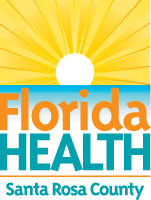It's a New Day in Public Health.
The Florida Department of Health works to protect, promote, and improve the health of all people in Florida through integrated state, county, and community efforts.
Through With Chew Week Prompts Discussion of Ways, Reasons to Quit Tobacco
February 21, 2022
Milton, Fla. – Each year, Through With Chew Week raises awareness about the dangers of smokeless tobacco use (chew, dip and snus) and the effective tools available to quit tobacco. This Through With Chew Week, Feb. 20-26, Santa Rosa County is encouraging smokeless tobacco users to set a quit date and use Tobacco Free Florida’s free and proven-effective resources to quit for good.
Mayor Heather Lindsay is preparing a proclamation to recognize Through With Chew Week 2022 in support of the outstanding efforts by the Santa Rosa County Department of Health to raise awareness of this issue.
Smokeless tobacco contains nicotine, the same addictive and toxic chemical found in other tobacco products.[i] Many chemicals in smokeless tobacco are known to cause several cancers including oral, esophageal and pancreatic cancers.[ii] Other common harmful effects include tumors affecting the nasal cavity, lungs, trachea, pancreas, liver and throat.[iii] Smokeless tobacco also contains a radioactive element called polonium-210 and harmful metals including arsenic and lead.[iv] The American Heart Association reports smokeless tobacco use can also increase the risk of stroke and heart disease.[v]
Smokeless tobacco usage rates across Florida are fairly low, but this is inconsistent in different areas throughout the state.[vi] Some rural counties in Florida report smokeless tobacco rates more than five times higher than the statewide average.[vii]
“As of 2019, 3.7% of Santa Rosa County adults used chewing tobacco, snuff, or snus compared to the state rate of 2.2%.” said Kristie Beckstrom. “We want people in our community to know Tobacco Free Florida has tools and services available to help anyone ready to quit tobacco, including chew.”
Those looking to quit tobacco can create a personalized quit plan using Tobacco Free Florida’s free Quit Your Way tools and services. The Quit Your Way program offers free tools and services like Phone Quit, Group Quit and Web Quit, in addition to individual tools like text support, a Quit Guide and helpful emails. Free nicotine replacement therapy – nicotine patches, gum or lozenges – are available to tobacco users who are 18 or older, if medically appropriate.
For more information on quitting tobacco, you can call 1-877-U-CAN-NOW (1-877-822-6669) or visit TobaccoFreeFlorida.com/quityourway.
About Tobacco Free Florida
The Florida Department of Health’s Tobacco Free Florida campaign is a statewide cessation and prevention campaign funded by Florida’s tobacco settlement fund. Since the program began in 2007, more than 254,000 Floridians have successfully quit using one of Tobacco Free Florida's free tools and services. There are now approximately 451,000 fewer adult smokers in Florida than there was 10 years ago, and the state has saved $17.7 billion in health care costs.[viii] To learn more about Tobacco Free Florida’s Quit Your Way services, visit www.TobaccoFreeFlorida.com or follow the campaign on Facebook at www.facebook.com/TobaccoFreeFlorida or on Twitter at www.twitter.com/tobaccofreefla.
[i] U.S. Department of Health and Human Services. The Health Consequences of Smoking: 50 Years of Progress. A Report of the Surgeon General. Atlanta, GA: U.S. Department of Health and Human Services, Centers for Disease Control and Prevention, National Center for Chronic Disease Prevention and Health Promotion, Office on Smoking and Health, 2014. Printed with corrections, January 2014.
[ii] National Cancer Institute and Centers for Disease Control and Prevention. Smokeless Tobacco and Public Health: A Global Perspective. Bethesda, MD: U.S. Department of Health and Human Services, Centers for Disease Control and Prevention and National Institutes of Health, National Cancer Institute. NIH Publication No. 14-7983; 2014.
[iii] National Cancer Institute and Centers for Disease Control and Prevention. Smokeless Tobacco and Public Health: A Global Perspective. Bethesda, MD: U.S. Department of Health and Human Services, Centers for Disease Control and Prevention and National Institutes of Health, National Cancer Institute. NIH Publication No. 14-7983; 2014.
[iv] National Cancer Institute and Centers for Disease Control and Prevention. Smokeless Tobacco and Public Health: A Global Perspective. Bethesda, MD: U.S. Department of Health and Human Services, Centers for Disease Control and Prevention and National Institutes of Health, National Cancer Institute. NIH Publication No. 14-7983; 2014.
[v] Piano MR, Benowitz NL, Fitzgerald GA, Corbridge S, Heath J, Hahn E, et al. Impact of Smokeless Tobacco Products on Cardiovascular Disease: Implications for Policy, Prevention, and Treatment: A Policy Statement from the American Heart Association. Circulation 2010;122(15):1520–44 [Accessed October 21, 2021]
[vi] Centers for Disease Control and Prevention (CDC). Behavioral Risk Factor Surveillance System Prevalence and Trends Data, 2019. Atlanta: U.S. Department of Health and Human Services, Centers for Disease Control and Prevention, National Center for Chronic Disease Prevention and Health Promotion, Office on Smoking and Health. [accessed October 21, 2021].
[vii] Centers for Disease Control and Prevention (CDC). Behavioral Risk Factor Surveillance System Prevalence and Trends Data, 2019. Atlanta: U.S. Department of Health and Human Services, Centers for Disease Control and Prevention, National Center for Chronic Disease Prevention and Health Promotion, Office on Smoking and Health. [accessed October 21, 2021].
[viii]Mann, Nathan M, Nonnemaker, James M., Thompson, Jesse. "Smoking-Attributable Health Care Costs in Florida and Potential Health Care Cost Savings Associated with Reductions in Adult Smoking Prevalence." 2016.




Connect with DOH